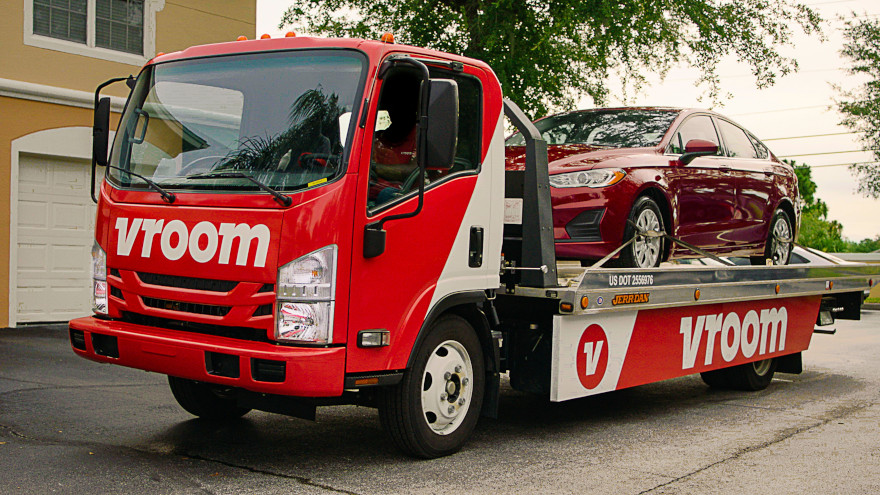Why New-Age Car Business Models Like Vroom Are Witnessing The Downfalls?
Vroom's highest market capitalisation has dropped 98% from $8.2 billion to $142 million.
Vroom, an on-demand automobile buying and selling firm with over $300 million in venture capital, has encountered a snag. As a result, the US-based online used-car retailer has cut off 11 % of its workforce, or around 120 individuals, spanning several divisions and locations.
Vroom has undergone ‘organisational restructuring’ as part of a review of ‘all parts of the business,’ according to a US SEC filing. The layoffs have been linked to the company’s goal of executing a long-term, cost-cutting-focused business strategy that was implemented last year. While difficult, Vroom’s decision to reduce staff this week is consistent with its commitment to its long-term roadmap and objectives for the year: prioritising unit economics and growth, improving customer experience, reducing cost per unit, and maximising liquidity.

Furthermore, Vroom expects to incur approximately $2 million in cash charges, primarily severance, and to achieve approximately $15 million in annualised cash savings as a result of the reduction in force, according to an SEC filing. Severance packages and job placement aid will be provided to impacted employees, and the firm will continue to hire for vital roles.
Just wait if you think all these layoffs are a result of the pandemic. According to the filing, in January 2023, Vroom gave pink slips to 275 employees, accounting for nearly 20% of the company’s total employment, excluding United Auto Credit Corporation. The latest round of layoffs reduces the company’s workforce to less than half of what it was in 2022.
There is data from 2018, and it can be discovered and confirmed that Vroom cut off a significant section of its workforce as part of a plan to “sharpen our focus on profitability.” According to a source, the business has shuttered two significant facilities in Dallas, Texas and Whitestown, Indiana, and eliminated around one-quarter of its personnel in New York City (where Vroom is headquartered) and Stafford, Texas.
Another company, like Vroom, from the same industry, had undergone layoffs.
Shift Technologies, a US-based online marketplace for buying and selling used vehicles, slashed its personnel by 30% in the first quarter to cut expenses and eliminate redundancy following its merger with CarLotz. CEO Jeff Clementz disclosed the employment layoffs during the results conference. Layoffs occur as the company’s sales fall in the fourth quarter and its operating deficit rises.

Why are these new-age car business models witnessing downfalls and engaging in layoff activities?
What do Vroom and Shift have in common? They are both automobile dealerships that emerged in the last 10-12 years and marketed themselves to be “new-age car dealerships” or “retailers” who were supposed to disrupt used automobile retailing in the twenty-first century. However, over the last 10-15 months, the market capitalisations of these companies have fallen by 90% to 98%. However, no other sector with a new-age disruptive approach to a category experienced as much decline as so-called new-age used car dealerships or retailers.
Vroom’s highest market capitalisation has dropped 98% from $8.2 billion to $142 million. Shift’s peak market capitalisation was $850 million, presently $43 million (a 95% drop).
So, what precisely occurred when so-called new-age used vehicle shops or dealerships disrupted the $8 trillion global automotive market?
These so-called new-age automobile retailers owned expensive inventory, refurbished vehicles with their centres/teams/supplies, and sold them through their own and operated physical locations. To begin with, this is an extremely pricey idea, given that the greatest margin in the used automobile sector is only 14.5%. Second, what is the nature of this new era or disruption? Isn’t this how used car sales have been conducted for the past 140 years?
None of the so-called new-age used vehicle shops or merchants has competence in used automobile procurement, especially when the market is largely unorganised or fragmented. Second, how can new-age businesses be super-efficient and renovation experts?
If you split certification from the traditional concept of refurbishment, which incorporates both refurbishing and certification—isn’t refurbishment intended to be a highly commoditised portion of the value chain? If you remove used automobile certification from refurbishing, the rest is only washing, cleaning, buffing, polishing, dry cleaning, touching, and little repair. This commodity activity does not need new-age methods or venture capital funding.

Then there’s the question of whether we truly believe that new-age corporations can run physical dealerships cheaper, better, or more effectively than Walmart, Target, Tesco, Carrefour, or CarMax. Physical centres may still make sense in developed economies like the US, Western Europe, and Japan because the occupancy cost for a physical dealership is 2% of gross revenue and the cost of capital is 3% to 6%. Still, the occupancy cost for a physical dealer in emerging markets is 8% to 10% of gross revenue, and the cost of capital can be as high as 18%.
Another reason firms like Vroom and Shift have in common is that their valuations/market caps increased dramatically between 2019 and 2021, before their current downfall.
That is when global investors became mindful of this so-called new-age automobile retailing disruptive model and began looking for different countries with large cheques and large valuations. Due to unprecedented FOMO, investors began writing large cheques to small and sometimes unproven automobile retailers in various countries as long as they could show that they had inventory, refurbishment capabilities, and physical dealerships to sell and that they were not as old as legacy players from the nineteenth century until 2010. But it all came crashing down in the last 10-15 months.
The business models of these firms have not affected used vehicle automotive selling. In aggregate, the physical branded dealerships dubbed “new-age” have lost $100 billion in shareholder equity in the previous 10-15 months, with each public firm experiencing a 92% decrease in value in this market.
Here’s how the used automobile retailing disruption may appear in the twenty-first century. It will be a pure-play e-commerce business model with just-in-time supply from third-party suppliers—no physical centre, refurbishment centre, warehouses, or people-heavy operations—but an end-to-end technology stack capable of handling, controlling, and curating all aspects of the used car food pipe or value chain through the use of technology, data, and AI.
Conclusion.
As a result, used vehicle retailing with inventory, refurbishing, and the physical dealership was not a new-age paradigm of automotive retailing for the twenty-first century but rather a bubble that had to burst one day. These firms attempted to repackage old wine in new bottles while branding it as a disruption in automotive retailing. Unfortunately, investors lost, and the game is over.





